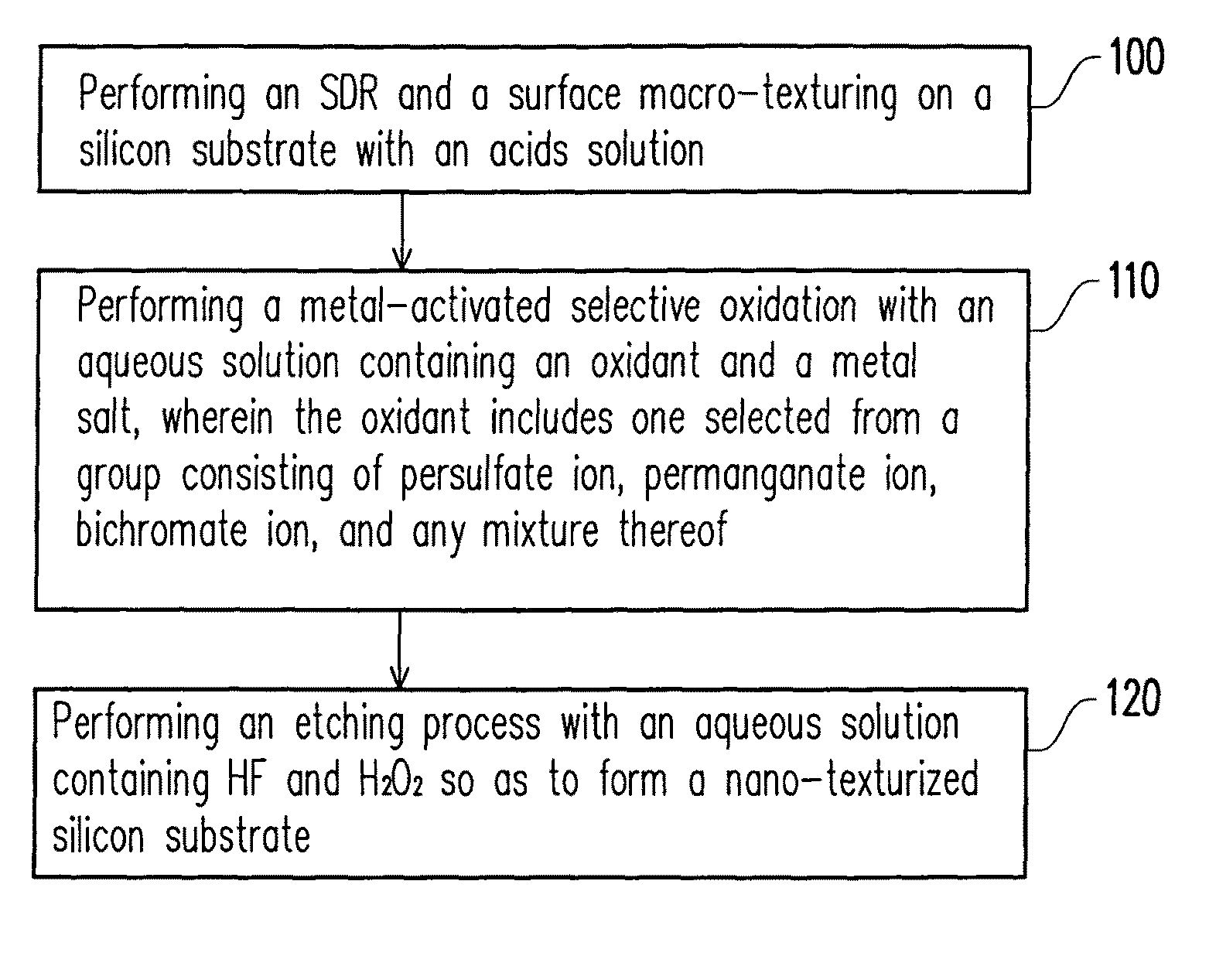Method for producing silicon substrate for solar cells
a technology of solar cells and silicon substrates, applied in semiconductor/solid-state device manufacturing, electrical equipment, semiconductors, etc., can solve the problems of poor surface passivation, high absorption coefficient of short-wavelength photons, and inability to meet multi-crystalline wafers, etc., to achieve suitable surface morphology and optical properties of silicon substrates.
- Summary
- Abstract
- Description
- Claims
- Application Information
AI Technical Summary
Benefits of technology
Problems solved by technology
Method used
Image
Examples
example 1
[0034]As-cut multicrystalline silicon substrates are rinsed with acetone and methanol or through a Piranha process. Then, the silicon substrates are etched for about 3 minutes under a temperature of 5-8° C. through using a solution of HF:HNO3:H2O at a volume ratio of 2.5:1:2.5, so as to perform the SDR and surface macro-texturing. Then, the silicon substrates are shortly immersed in a solution of KOH:H2O at a volume ratio of 1:50, so as to remove the formed nano-porous silicon layer. Then, the silicon substrates are rinsed with deionized water and then dried in a N2 flow.
[0035]Thereafter, the silicon substrates are first dipped in HF for 2-3 minutes in order to remove the native oxide layer, and then the metal-activated selective oxidation is performed. The metal-activated selective oxidation is performed by putting the silicon substrate into a solution of 0.1 M Na2S2O8 and 0.1 M AgNO3 at a volume ratio of 2:1 while stirring mildly at room temperature. The duration of the whole meta...
example 2
[0039]The pre-treatments in Table 1 are respectively performed on different multicrystalline silicon substrates.
[0040]
TABLE 1SDRPolishingHF:HNO3:H2O = 2.5:1:2.5HF:HNO3 = 1:255-8° C., 3 minutes3-5 minutes, at room temperature
[0041]Then, the silicon substrates after being processed by different pre-treatments are soaked in HF for 2-3 minutes, for removing the native oxide layer, and then the silicon substrates are macro-texturized or polished. Then, the metal-activated selective oxidation is performed by putting the silicon substrates into the solution of 0.1 M Na2S2O8 and 0.1 M AgNO3 at a volume ratio of 5:1 at room temperature under agitation. The whole metal-activated selective oxidation is finished after approximately 5 minutes, and then the silicon substrates are rinsed with deionized water and then dried in the N2 flow.
[0042]Afterwards, the silicon substrates after the oxidation are put into the aqueous solution containing HF and H2O2 (the volume ratio of HF:H2O2:H2O is 1:5:10),...
example 3
[0044]The multicrystalline silicon substrates are produced through the manner of Example 1, but in the metal-activated selective oxidation process, Na2S2O8 and AgNO3 at the volume ratio of 10:1 is used.
[0045]FIG. 4A is a graphical plot of reflectivity vs. wavelength after merely the SDR and the macro-texturing step are finished and after the nano-porous silicon layer is removed, and FIG. 4B is a graphical plot of reflectivity to wavelength after finishing all the steps. As can be known by comparing FIG. 4A with FIG. 4B that, only after the metal-activated selective oxidation and the etching process are performed on the silicon substrates, the reflectivity suppression effect can be achieved in the whole measured interval of wavelengths. FIGS. 5A and 5B are respectively SEM pictures of the surface of the silicon substrate at the stages of FIGS. 4A and 4B.
[0046]To sum up, in the present invention, the reflectivity can be easily reduced through a procedure consisting of as simple proces...
PUM
 Login to View More
Login to View More Abstract
Description
Claims
Application Information
 Login to View More
Login to View More - R&D
- Intellectual Property
- Life Sciences
- Materials
- Tech Scout
- Unparalleled Data Quality
- Higher Quality Content
- 60% Fewer Hallucinations
Browse by: Latest US Patents, China's latest patents, Technical Efficacy Thesaurus, Application Domain, Technology Topic, Popular Technical Reports.
© 2025 PatSnap. All rights reserved.Legal|Privacy policy|Modern Slavery Act Transparency Statement|Sitemap|About US| Contact US: help@patsnap.com



